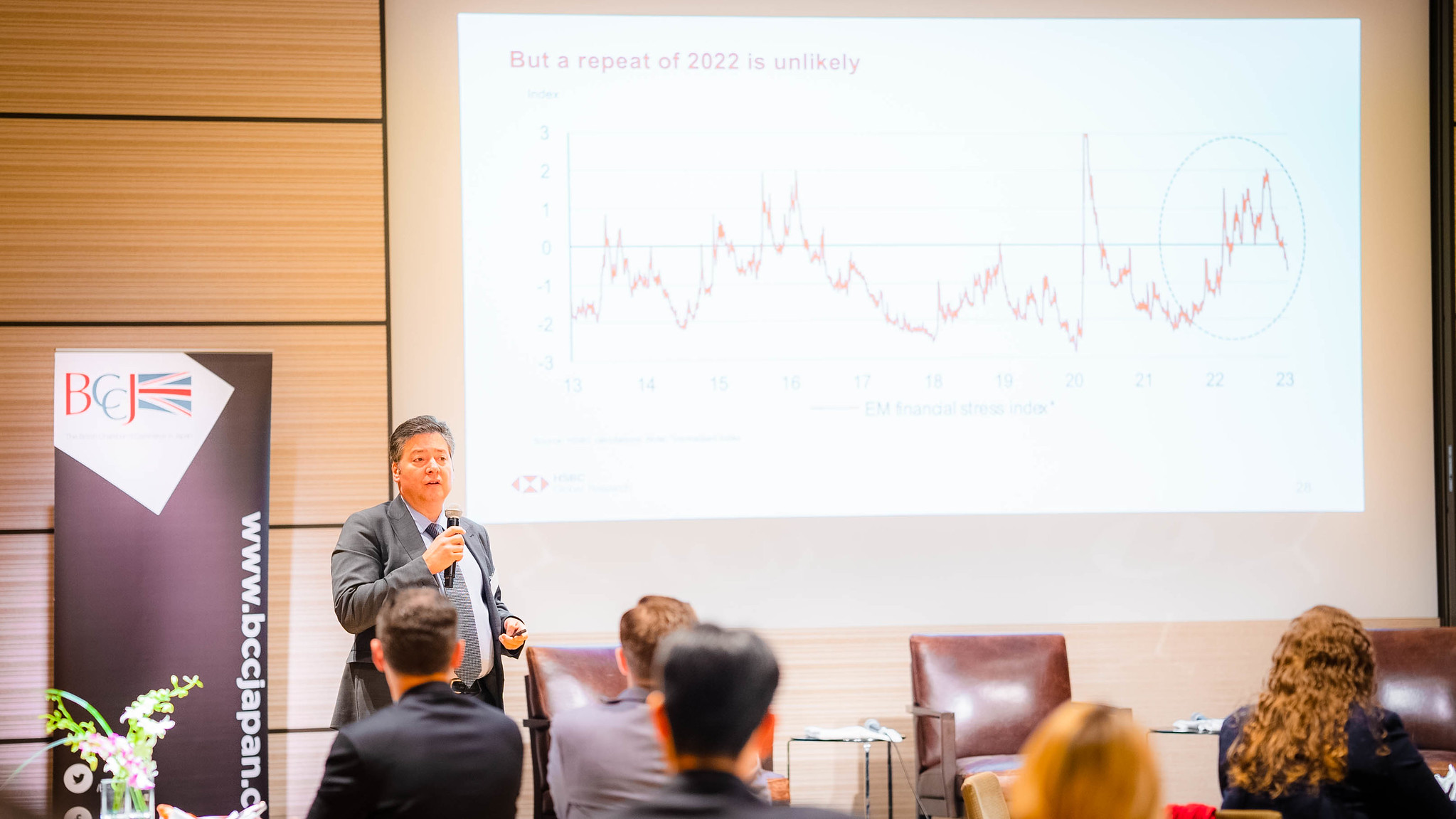Member? Please login
Economic bounce for the Year of the Rabbit

Written by Sterling Content
February 22, 2023
Past Event Round Ups
The Year of the Rabbit could enjoy an economic bounce as China reopens and the US Federal Reserve System (Fed) gradually eases back on monetary tightening. That is good news for Japan and the rest of the region, according to HSBC economists.
HSBC experts Dr Frederic Neumann, managing director and chief Asia economist, and Dr Murat Ulgen, global head of emerging markets research, told the brighter news to members of the British Chamber of Commerce in Japan at its event: “Global Economic Forecast 2023.”
Moderator Naomi Davies, Counsellor, Economic and Finance, at the British Embassy Tokyo, encouraged the economists to look back as well as forward to provide their insights for 2023.
Neumann began by explaining the key shocks of 2022, and why they would no longer be so damaging in 2023.
“The first big shock of 2022 was the Fed raising rates … very few people a year ago would have forecast the Fed raising rates to 4.75%,” he said. “The second big shock was the Ukraine invasion, which disrupted global commodity markets and caused a spike in oil prices and food prices … The third big shock was recession in China. China officially grew by 3% last year, but most people would say it felt like a recession—and probably the first one in 30 years.”
However, this year all such shocks should “start to normalise,” he said, adding that “the Fed is coming to the end of its tightening cycle … in commodity markets we’ve seen some normalisation, energy markets have adjusted; and then we’ve seen the reopening of China.
“So this year should be the year of stabilisation. Yes, there are tremendous risks out there, but in Asia we should see a recovery in economic growth and the stabilisation of financial markets,” he predicted.
Regarding China, he said Asia’s biggest economy should post GDP growth of at least 5% this year due to upturn in consumer demand and recovery in the property sector.
Emerging market recovery
Ulgen then focused attention on emerging markets (EMs), which are set for a better year largely thanks to China’s post-pandemic reopening.
A repeat of 2022’s EM losses is unlikely, given China’s large share of EM exports, he predicted.

“Before China joined the World Trade Organization, only about 5% of EM exports were to China. These have since tripled or quadrupled, not only in manufacturing but also services and tourism,” he said.
Ulgen expects EM to outpace their developed counterparts in 2023, with the growth gap widening to its highest level since 2013.
Asked by Davies to consider the most positive signs for 2023, Neumann suggested a “strong cyclical rebound in China” would benefit not only China but also Japan, South Korea and the region, with Ulgen echoing the call.
Regarding risks, Ulgen pointed to underlying inflation remaining higher for longer, while Neumann noted geopolitics.
“Some of the obvious risks are the Fed raising rates too much, causing a US recession. We believe the Ukraine–Russia war, economically, has been digested … but global commodity markets are in an unusual position; we have extremely tight supply in virtually all commodities,” he said.
Neither economist predicted a global recession, however, largely thanks to the pick-up of China’s economy, which would provide a counterweight to any further slowdown in Europe or the United States.
Yet China’s recovery could complicate decision-making for the US’ central bank, since increased commodity demand from the world’s second-largest economy could raise commodity prices, just when the Fed is attempting to wind back its restrictive policy.
Asked about the degree of similarity between the economic journeys of India and China, Neumann said the South Asian giant is in a “different phase of its development,” comparable to China in the 1990s.
Yet the signs of a “manufacturing renaissance” in India pointed to it entering a commodity-intensive growth phase, which could drive commodity prices higher and ultimately help India industrialise as its East Asian rivals have done.
Japan’s inflation shock
Questioned about Japan’s inflation pressures, Neumann described the recent uptick in prices as a “psychological shock” for consumers.
“We’ve seen a few announcements of companies raising wages aggressively, but we have to wait for the next wages round to get sustainable wage increases. I’m still sceptical that the wage rises will compensate for the inflation shock,” he said.
While firms such as Yamaguchi-based retail multinational Fast Retailing have moved to lift wages, Neumann said it could be more challenging for Japan’s small and mid-sized enterprises, which employ the bulk of Japan’s workforce.

However, higher wage growth would allow the Bank of Japan (BOJ) to exit its current ultra-easy policy. “If they get some wage growth they can say they’ve delivered,” he said.
Neumann said the appointment of a new central bank governor could allow for a “reassessment” of policy at the BOJ, with inflation expected to “normalise” by year-end.
Indeed, not long after the BCCJ event, academic Kazuo Ueda was named the next central bank governor in a move expected to heighten the change of an end to the BOJ’s unpopular yield control policy.
Asked about the yen–dollar exchange rate, Neumann said HSBC projected a strengthening by year-end, based on expectations of the Fed easing policy and the BOJ adjusting its policy, thereby strengthening the Japanese currency.
“But, if US inflation sticks, the Fed may have to raise rates further … that’s the risk factor,” he said.
Despite market expectations, Neumann suggested the Fed may not start cutting interest rates until “well into 2024.”
The International Monetary Fund (IMF) recently projected a “moderation” of adverse risks for the world economy, suggesting some optimism for 2023.
With the IMF projecting 1.8% GDP growth for Japan this year, an improved international outlook would be extremely welcome after the global shocks of 2022.







